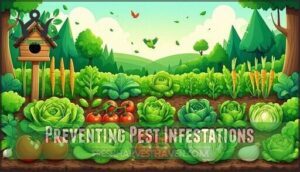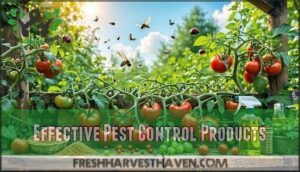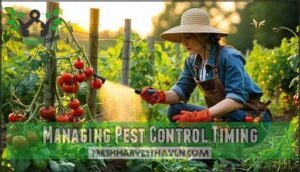This site is supported by our readers. We may earn a commission, at no cost to you, if you purchase through links.

Beneficial insects like ladybugs and lacewings naturally control aphids, while hand-picking hornworms keeps populations manageable.
Neem oil disrupts pest life cycles, and insecticidal soap suffocates soft-bodied insects like whiteflies.
Bacillus thuringiensis (Bt) specifically targets caterpillars without affecting beneficial species.
Companion plants such as basil and marigolds repel common tomato pests naturally.
These organic approaches maintain your garden’s ecosystem balance while ensuring food safety.
The timing and application techniques for these methods can make the difference between thriving plants and pest-damaged crops.
Table Of Contents
- Key Takeaways
- Identifying Tomato Pests
- Safe Pest Control Methods
- Preventing Pest Infestations
- Effective Pest Control Products
- Managing Pest Control Timing
- Frequently Asked Questions (FAQs)
- How do I keep pests from eating my tomato plants?
- Are tomato plants prone to pests?
- How do you get rid of bugs on tomato plants?
- Can mites kill tomato plants?
- What plants keep pests away from tomatoes?
- Are all insects a tomato pest?
- What is safe to spray on tomatoes?
- What is the safest insecticide for vegetables?
- What insecticide is safe for tomato plants?
- How to protect tomato plants from being eaten by insects?
- Conclusion
Key Takeaways
- Use beneficial insects and natural sprays – Deploy ladybugs and lacewings to control aphids, while applying neem oil or insecticidal soap to disrupt pest life cycles without harming your family or beneficial species.
- Monitor your plants weekly for early detection – Check leaf undersides for eggs and damage patterns, as catching pests early prevents infestations that can destroy entire crops.
- Implement companion planting strategies – Plant basil, marigolds, and nasturtiums around your tomatoes to naturally repel hornworms, nematodes, and aphids while attracting pollinators.
- Time your treatments with pest life cycles – Apply organic controls like Bt during early larval stages and spray during optimal weather conditions (65-85°F, low wind) for maximum effectiveness.
Identifying Tomato Pests
You’ll need to spot tomato pests early before they destroy your entire crop.
Learning to identify common culprits like aphids, hornworms, and whiteflies by their damage patterns saves you time and money on ineffective treatments, which is crucial for effective pest management.
Common Tomato Pests
Most tomato gardeners encounter several destructive pests during the growing season.
Aphids cluster on stems, causing yellowing leaves through sap extraction. Hornworms, despite reaching 3-4 inches, camouflage perfectly while stripping foliage overnight.
Whiteflies transmit diseases and weaken plants. Stinkbugs puncture developing fruit, creating unsightly blemishes.
Flea beetles chew distinctive shot-hole patterns in leaves. Cutworms sever young plants at soil level during nighttime feeding.
Fruitworms tunnel directly into ripening tomatoes, ruining harvests.
Pest Damage Symptoms
Spotting trouble early keeps your tomatoes healthy and productive.
Leaf discoloration appears first—yellow patches spreading from aphid feeding or mottled patterns from virus-carrying pests. Growth stunting follows as insects drain nutrients.
Look for fruit damage like dimpled spots from stink bugs or entry holes from fruitworms. Stem issues include wilting from cutworm cuts near soil level.
Black droppings on leaves signal hornworm presence, while powdery residue indicates aphid infestations affecting plant health.
Employing pest identification methods is essential for early intervention.
Pest Identification Methods
Visual Pest Identification starts with regular plant inspections. Look beyond obvious damage symptoms to spot problems early.
Effective pest identification methods combine multiple approaches for accurate results. Damage Symptom Analysis reveals feeding patterns that point to specific pests. Trapbased identification using yellow sticky cards catches flying insects like whiteflies and aphids.
Pest Identification techniques include:
- Visual Pest ID with magnifying glass for detailed leaf examination
- Microscopic Pest ID using portable microscopes for tiny mites
- Pest Lifecycle Stages monitoring from eggs to adults
- Sticky trap placement near affected plants for flying pest capture
- Photography documentation for comparison with pest identification guides
Safe Pest Control Methods
You can protect your tomatoes without harming your family, pets, or beneficial insects by using organic methods that target pests specifically.
These safe alternatives work just as effectively as chemical pesticides while supporting a healthy garden ecosystem.
Organic Pest Control Options
Once you’ve identified which pests are attacking your tomatoes, organic pest control methods offer safe, effective solutions.
Beneficial insects like ladybugs consume up to 5,000 aphids during their lifetime, while lacewing larvae eat over 200 soft-bodied insects weekly.
DIY sprays using garlic, soap, or baking soda provide immediate relief from infestations. Look for OMRI Products to guarantee true organic standards. Effective sprays available here can help control pests.
Organic barriers like floating row covers block 95% of flying pests. Maintaining soil health through proper drainage and nutrition strengthens plants against attacks, making your organic gardening efforts more successful long-term.
Natural Pest Control Products
When shopping for natural pest control products, you’ll find several proven options that protect your tomatoes without harsh chemicals.
OMRI certification guarantees these natural pesticides meet organic standards for safe garden use.
Effective natural barriers include:
- Neem oil – Disrupts pest life cycles and reduces fruit worm populations by 72%
- Insecticidal soap – Eliminates 95% of soft-bodied pests like aphids on contact
- Diatomaceous earth – Dehydrates crawling insects, limiting populations by 60%
- Bacillus thuringiensis – Reduces hornworm larvae by 85% within 48 hours
- DIY recipes – Mix castile soap with water for budget-friendly pest control
These products work alongside beneficial insects to create thorough tomato protection.
Habitat restoration can further boost these efforts by creating balanced garden ecosystems.
Integrated Pest Management
Rather than depending on single solutions, integrated pest management combines multiple strategies for thorough tomato pest control.
This systematic approach delivers IPM benefits through coordinated monitoring, biological controls, and sustainable production methods.
Your integrated pest management strategy should include:
- Regular scouting to detect pest populations before they cause economic damage
- Beneficial insects like parasitic wasps and predatory beetles for natural pest control
- Cultural practices including proper plant spacing and garden sanitation
- Physical barriers such as row covers and copper tape around plants
- Targeted treatments using OMRI-certified products only when thresholds are exceeded
This sustainable pest control approach maintains soil health while ensuring long-term control reliability and economic viability for your garden.
Preventing Pest Infestations
The best defense against tomato pests starts before they arrive at your garden.
You’ll prevent most infestations by maintaining clean growing conditions, rotating your crops annually, and choosing the right companion plants to naturally repel harmful insects.
This approach ensures a proactive stance against potential threats, emphasizing the importance of companion plants in pest management.
Garden Hygiene Practices
Clean gardens prevent pest infestations before they start.
Tool sanitation between plants stops disease spread—wipe pruners with rubbing alcohol. Weed removal eliminates pest hiding spots and competition for nutrients. Debris cleanup removes overwintering pest eggs and larvae from fallen leaves and plant material.
Mulch management keeps organic matter fresh and properly spaced from plant stems. Water at soil level to prevent leaf diseases that weaken plants.
Soil solarization during hot months kills pest eggs naturally. These garden hygiene practices create an environment where natural pest control methods work better, reducing your need for organic methods later.
Crop Rotation Techniques
Smart crop rotation techniques prevent pest buildup and improve soil health. You can’t plant tomatoes (Solanaceae family) in the same spot repeatedly without consequences.
Rotation planning requires three simple steps:
- Wait 3-4 years before replanting tomatoes in the same location
- Rotate with different plant families like legumes (beans) or grasses (corn)
- Track your garden layout using simple sketches or apps
This approach starves soil-dwelling pests of their preferred hosts. Cover crops like clover between seasons add nitrogen and prevent weeds. Rotation benefits include breaking pest life cycles and maintaining sustainable agriculture practices for long-term garden pest control.
Companion Planting Strategies
Companion planting creates a living shield around your tomatoes through strategic plant partnerships.
Basil naturally repels hornworms while enhancing tomato flavor through aromatic compounds.
Marigolds secrete alpha-terthienyl, reducing nematode pressure by 35%.
Nasturtiums act as trap crops, drawing aphids away from your precious tomatoes.
You can find various companion planting products to assist in this process.
These companion plants attract pollinators and boost biodiversity, creating a balanced ecosystem that supports growth naturally.
pollinators
Companion planting is a method that creates a balanced ecosystem and supports growth through strategic plant partnerships and aromatic compounds.
The use of companion plants can help reduce pest pressure and improve overall plant health.
Effective Pest Control Products
When chemical pesticides fail against resistant pests, you need proven organic alternatives that protect your tomatoes without harming beneficial insects or your family.
These four effective pest control products offer targeted solutions that work with nature’s systems rather than against them.
Insecticidal Soap Solutions
Insecticidal soaps target softbodied pests like aphids and whiteflies by disrupting their cell membranes. These fatty acid solutions achieve up to 80% pest mortality when applied directly to insects.
Soap Application Tips: Spray leaf undersides in early morning or evening for maximum contact. Reapply every 5-7 days since soaps only affect pests present during spraying.
Homemade Soap Efficacy: Commercial formulations outperform DIY soapwater solutions due to precise fatty acid concentrations. OMRI-certified products guarantee organic standards.
Soap Safety Precautions: Test on small leaf sections first to prevent plant sensitivity. Consider using tomato-based options for enhanced pest control. These natural spray options won’t harm beneficial insects like ladybugs when used correctly, making them ideal for integrated pest management.
Neem Oil Based Products
Beyond traditional contact pesticides, neem oil based products offer systemic protection that disrupts pest feeding and reproduction cycles.
This natural extract contains azadirachtin, which inhibits over 200 pest species while remaining safe for beneficial insects.
Apply neem oil to leaf undersides every 7-14 days, targeting early morning or evening hours.
Field trials show a 75% reduction in fruitworm populations, and OMRI-certified brands like Azaguard provide organic gardening practices compliance.
Unlike synthetic alternatives, neem oil breaks down rapidly, allowing safe pesticides use near harvest while building long-term neem resistance management.
Pyrethrin Sprays
Pyrethrin sprays deliver rapid knockdown power against tomato pests, with studies showing over 90% effectiveness within 24 hours.
These natural pest control products target aphids, caterpillars, and beetles while breaking down quickly in sunlight.
Pyrethrin safety makes them suitable for organic sprays, but avoid overuse to prevent pyrethrin resistance.
Apply during pest feeding times for maximum pyrethrin efficacy.
Consider rotating with pyrethrin alternatives for sustainable control.
Bacillus Thuringiensis
Bacillus thuringiensis (Bt) targets caterpillar pests with surgical precision through its natural bacterial proteins.
This organic certification-approved biological control method achieves 70-95% caterpillar control within one week of Bacillus thuringiensis application.
You’ll get best BT effectiveness by spraying early-stage larvae, as older caterpillars resist treatment.
Application methods using liquid concentrates provide superior coverage compared to dust formulations.
Resistance management requires rotating Bt with other natural pest control methods to maintain long-term effectiveness in your organic solutions strategy.
Encouraging beneficial insects, like ladybugs control aphids, can also help manage pests.
Managing Pest Control Timing
Timing your pest control applications correctly can mean the difference between thriving tomatoes and crop failure.
You’ll need to match your spray schedule with pest life cycles and weather patterns to maximize effectiveness while protecting beneficial insects.
This approach ensures that your efforts are targeted and efficient, making the most of your pest control applications.
Seasonal Pest Control Schedules
With the right products in your arsenal, you’ll need to time their application perfectly for maximum effectiveness.
Spring Pest Control starts when temperatures consistently reach 60°F—monitor for aphids and flea beetles, applying horticultural oils at the seedling stage.
Summer Pest Control requires weekly hornworm inspections and neem oil applications every 7-10 days during fruit set.
Fall Pest Control focuses on leaf miners and spider mites during hot, dry periods.
Winter Pest Control involves garden cleanup and planning next season’s Schedule Adjustments based on your region’s climate patterns.
Weather Dependent Spraying
Weather conditions can make or break your pest control efforts.
Temperature effects determine whether treatments work or harm plants, while wind considerations prevent drift and guarantee even coverage.
- Apply sprays during early morning hours when temperatures stay between 65-85°F and wind speeds remain under 10 mph
- Check rain impact timing on product labels – most treatments need 4-6 hours of dry weather for proper absorption
- Monitor humidity influence and sunlight sensitivity to avoid leaf burn and maximize insecticide application effectiveness
Pest Life Cycle Monitoring
Understanding each pest’s development timeline helps you strike at the right moment.
Track Egg Hatch Timing for aphids and hornworms, then target vulnerable pest larvae during their feeding stages.
| Pest Stage | Monitoring Focus |
|---|---|
| Adult Emergence Patterns | Track when adults appear to predict egg laying |
| Larval Stage Duration | Monitor feeding periods for best control timing |
| Pupation Site Selection | Locate pest dwelling places to break cycles |
Weekly pest monitoring reveals Overwintering Strategies and helps you anticipate seasonal peaks, making your pest life cycle management more effective.
Using insecticidal soaps effectively can target pest cell membranes.
Early Detection Methods
Pest monitoring becomes effective when you catch problems before they explode into infestations. Daily visual inspection of your tomato plants reveals early warning signs that save entire crops.
- Leaf Inspection – Examine undersides weekly for aphid clusters and egg masses using a magnifying glass
- Soil Monitoring – Check around plant stems at dawn for cutworm activity and fresh damage
- Trap Placement – Position yellow sticky cards at plant height to capture flying pests early
- Visual Cues – Watch for subtle leaf discoloration, wilting patterns, and unusual growth patterns
- Growth Patterns – Document plant development to spot pest-related stunting or deformation quickly
These steps are crucial for early detection and prevention of pest infestations, allowing for timely intervention to protect your tomato crops.
Frequently Asked Questions (FAQs)
How do I keep pests from eating my tomato plants?
Can hungry bugs turn your prize tomatoes into Swiss cheese?
Use neem oil, diatomaceous earth, or castile soap sprays to safely eliminate aphids, hornworms, and other pests without harming beneficial insects or your family.
Are tomato plants prone to pests?
Yes, tomatoes attract numerous pests including aphids, hornworms, cutworms, whiteflies, and flea beetles.
You’ll need proactive management since these insects can quickly damage or destroy your plants through feeding and disease transmission, which is a critical aspect of maintaining healthy plants.
How do you get rid of bugs on tomato plants?
Ladybugs consume up to 50 aphids daily, making them powerful allies against tomato pests.
You’ll control bugs effectively using neem oil sprays, beneficial insects like ladybugs, or homemade garlic-soap solutions that target pests without harming your plants, which also makes them a powerful tool.
Can mites kill tomato plants?
Spider mites can severely damage your tomato plants through their feeding habits.
These tiny pests suck plant juices, causing yellowing leaves, stippling, and webbing that weakens plants and reduces fruit production substantially, which can be considered a substantial loss.
What plants keep pests away from tomatoes?
Surprisingly, certain plants act like bodyguards for your tomatoes, naturally repelling harmful insects.
You’ll find marigolds, basil, nasturtiums, and garlic create protective barriers that deter aphids, hornworms, and other common pests effectively.
Are all insects a tomato pest?
Not every insect threatens your tomatoes.
Many beneficial insects like ladybugs, green lacewings, and parasitic wasps actually protect your plants by eating harmful pests such as aphids, hornworms, and whiteflies naturally.
What is safe to spray on tomatoes?
When in doubt, prevention beats cure.
You can safely spray neem oil, castile soap solutions, or homemade garlic mixtures on your tomatoes.
These organic options effectively control aphids and hornworms without harming beneficial insects or contaminating your harvest, using organic methods.
What is the safest insecticide for vegetables?
Neem oil stands as your safest vegetable garden insecticide. It’s OMRI-certified organic, targets pests without harming beneficial insects, and breaks down naturally without toxic residues.
What insecticide is safe for tomato plants?
While chemical pesticides pose risks to beneficial insects and pets, neem oil offers a safer alternative.
This OMRI-certified organic insecticide effectively controls aphids, hornworms, and whiteflies without harming ladybugs or other helpful predators in your tomato garden, making it a valuable tool for those seeking organic methods.
How to protect tomato plants from being eaten by insects?
You can protect your tomato plants using beneficial insects like ladybugs and lacewings.
Natural sprays with neem oil or garlic, companion planting with marigolds and basil, are methods to consider.
Regular garden cleaning to eliminate pest hiding spots is also crucial for protecting your plants.
Conclusion
Victory grows from protecting your garden fortress.
You’ve learned proven safe pest control for tomatoes that works without compromising your family’s health. From beneficial insects like ladybugs controlling aphids to neem oil disrupting pest cycles, these organic methods create lasting protection.
Regular monitoring combined with companion planting and targeted treatments like Bt keeps your tomato plants thriving. Apply these techniques consistently throughout the growing season for maximum effectiveness, using methods that ensure lasting protection.








Kayemba Lukka baanabakintu
August 10, 2025 at 12:14 PM
I fought a big challenge in my tomato garden, a pest which is like a butterfly, it lies eggs, the lava destroys 60% and the adult finishes. Which pesticide can I use